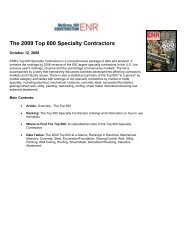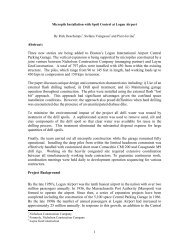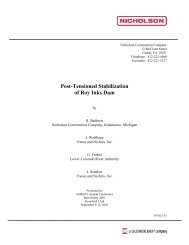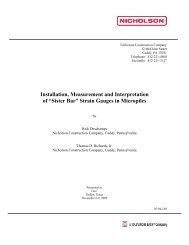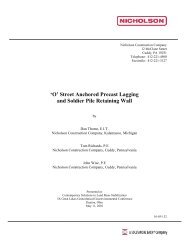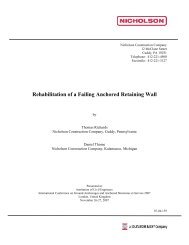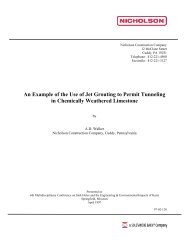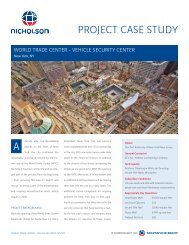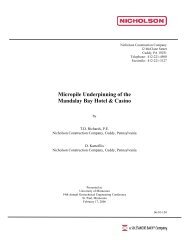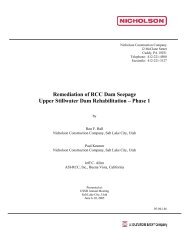recent advances in large diameter diaphragm wall shafts
recent advances in large diameter diaphragm wall shafts
recent advances in large diameter diaphragm wall shafts
- No tags were found...
Create successful ePaper yourself
Turn your PDF publications into a flip-book with our unique Google optimized e-Paper software.
pRR-uuN hdθdθ2N h dθ2pRdθpN hFigure 2 : Free body diagram of a circularsegment.Figure 1. Clamshell bucket.the reaction to the external pressure produces acompressive "hoop" force <strong>in</strong> the <strong>wall</strong> whichresists the tendency to converge. This isexpressed <strong>in</strong> Figure 2 where a free bodydiagram of a segment of <strong>wall</strong> is shown. Thehoop force , N h , is related to theapplied external pressure by the relationship :N h = p R (1)No extra support is required to balance theexternal forces. This is the reason why circular<strong>wall</strong>s are <strong>in</strong>herently stable provided the hoopforce does not exceed the limits of the materialproperties.A circumferential stiffness that relates theapplied pressure to the radial displacement, ∆R,can be def<strong>in</strong>ed as follows :P = E t ∆R / R 2 (2)"E" is Young’s modulus of r<strong>in</strong>g material and t isthe <strong>wall</strong> thickness. This relationship obta<strong>in</strong>ed fora r<strong>in</strong>g is used for the three dimensional circular<strong>wall</strong> under axisymmetrical pressure diagrams.Advantages of Circular Diaphragm WallsBased on the previous remarks, circular<strong>diaphragm</strong> <strong>wall</strong>s provide a lot of advantagescompared to plane <strong>wall</strong>s. They do not needsupports such as struts or tie-back anchors.Excavation works can be achieved quicklywithout complicated construction sequence orcoord<strong>in</strong>ation between the excavator and anchor<strong>in</strong>staller.Another benefit of the <strong>in</strong>herently stable circular<strong>diaphragm</strong> <strong>wall</strong>s lies <strong>in</strong> the much lessened needfor embedment to provide <strong>wall</strong> stability.Obviously other criteria for embedment must beconsidered, such as hydraulic stability (i.e.pip<strong>in</strong>g) and basal stability, but embedment formechanical stability of toe is unnecessary.It should also be recognized that as the hoopforce provides a stiff cont<strong>in</strong>uous support to the<strong>wall</strong>, the bend<strong>in</strong>g moment and shear force <strong>in</strong> the<strong>wall</strong> rema<strong>in</strong> generally small lead<strong>in</strong>g to "light"re<strong>in</strong>forcement ratios.Design of Circular Diaphragm WallsWall Alignment. The design of circular<strong>diaphragm</strong> <strong>wall</strong>s can require some unusualconsiderations which leads to a need for



